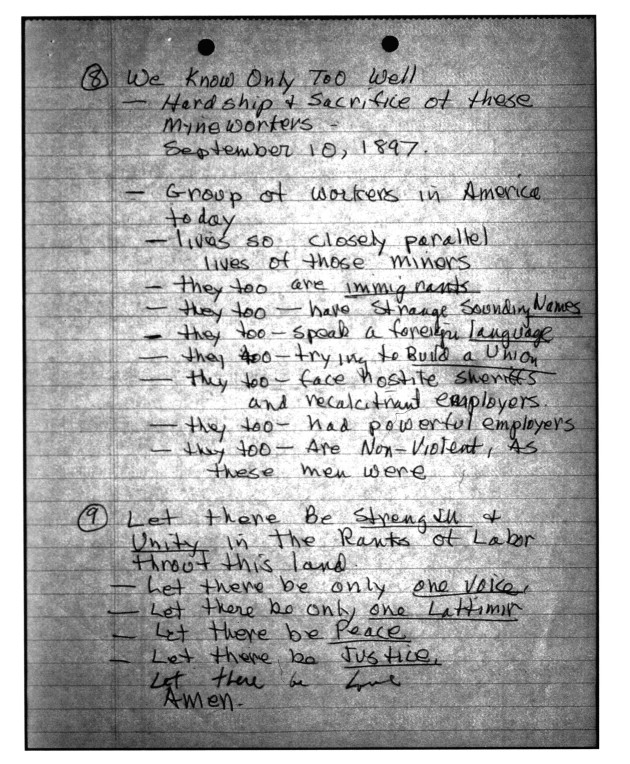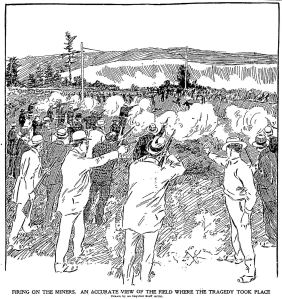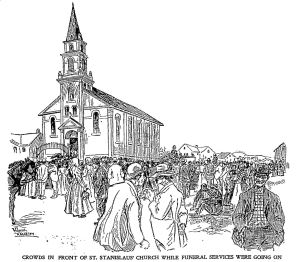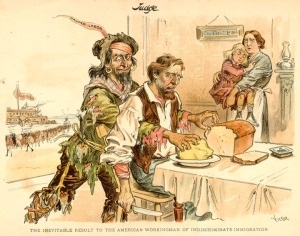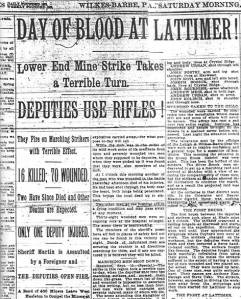Cesar Chavez at Lattimer, 1972
October 22, 2014 Leave a comment
In 1972 a monument to the Lattimer Massacre was dedicated at the corner of Quality Road and Main Street Lattimer. A massive memorial gathering commenced with over 700 people in attendance. Among the speakers was Cesar Chavez, a major figure in the efforts to organize the farm workers of the country. Chavez was busy at the moment advocating a boycott of grapes all over the country, zipping across the country zipping from interview to rally to speech. After attending the 117th annual memorial service we became interested in whether we might be able to find a copy of Chavez’s speech. We were specifically interested in how Chavez would have related the plight of the Eastern European laborers who struck in 1897 to the organizing movements of his time.
In the time since Chavez’s visit, Hazleton has become host to a large Spanish-speaking population, many of whom work in the warehousing and manufacturing jobs in the region. How would this visit by this great figure in America’s recent history resonate with their everyday life? Namely, how might it serve to connect their lives to the long history of work and struggle in the region?We found a copy of Cesar Chavez’s handwritten notes to the speech he delivered at Lattimer in 1972 on microfilm from the archives of the United Farm Workers. We have transcribed them below. Below that are scans of the handwritten notes. An earlier draft was also found which contains some additional marginalia notated at the bottom:
Cesar Chavez — Speech Notes at Lattimer Massacre Monument
1) (Greetings to leaders present)
2) (Thanks to memmbers of Monument Committee for inviting me—- for work they are doing—-
3) In this — 75th year —- We come to [Lattimer] to honor
-the past
-pay tribute to the present
-Organize for the future4) In their 75th year — gather at site where good men
Peaceful Union Men —-
Seeking bread + Justice —- were massacred
in an unprecedented Act of Brutality
—endowing all working men + women
— Inheritance—- Generation5) No Better treatment to Power of Non-Violence +
Might of Sacrifice to be
Found anywhere in this land6) These Martyred Immigrants
-only crime at the time
their poverty —their strange sounding names —
their foreign tongues.-If could speak to us today
They would tell us plainly
-in the words of another labor martyr
-DONT MOURN FOR US, ORGANIZE.7) It [is] fitting + proper, unveil memorial plaque commemorating the 75th year at Tragic Event
— For only in Preserving Labor’s Past, can we preserve labor’s future.8) We Know Only Too Well
— Hardships + Sacrifice of these
mineworkers
September 10, 1897
— Group of workers in America today
— lives so closely parallel
lives of those miners
— they too are immigrants
— they too– have strange sounding names
— they too — speak a foreign language
— they too — trying to Build a Union
— they too — face hostile sheriffs
and recalcitrant employers
— they too — had powerful employers
— they too — Are Non-Violent, As
these men were9) Let there be Strength +
Unity in the Ranks of Labor
throughout this land
–Let there be only one voice
–Let there be only one Lattimer
–Let there be Peace.
–Let there be Justice.
Let there be Love
Amen.[an earlier draft contains some memos in the margins that Cesar may have addressed in the speech. Some text is inscrutable, but what is readable is transcribed below]
*Companies who ???? Promote violence
*violence & frustratingstriking lettuce workers with injunctions and unconstit. laws
*farmworkers have their martyrs
*Pixley Cotton – grape strike
“Pixley massacre” 1931
*(3)(13)? strikers shot down during union meeting in Pixley



